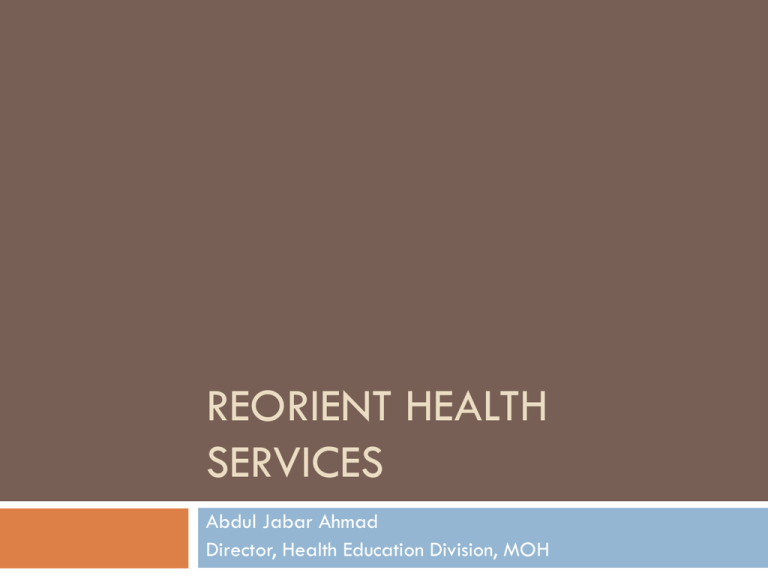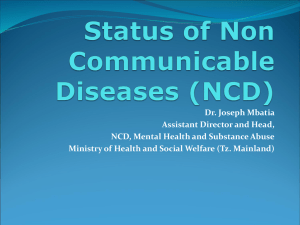
REORIENT HEALTH
SERVICES
Abdul Jabar Ahmad
Director, Health Education Division, MOH
NCD IN MALAYSIA
About 70% of total MOH’s health clinic attendances
are related to NCD
NCD accounts for over 20% of total hospitalization in
MOH hospitals (excluding normal deliveries)
Heart disease and stroke are in top five most common
cause of death in MOH hospitals
Heart disease and stroke also most common cause of
premature death (<60 yrs)
Malaysia ranks 6th among Asian countries with high
adult obesity rate
PREVALENCE OF SELECTED NCD &
NCD RISK FACTORS IN MALAYSIA
NHMSII (1996)
MANS (2003)
NHMSIII (2006)
Age group
≥18 yrs
≥18 yrs
≥18 yrs
Smoking
24.8%
NA
21.5%
Physically inactive
88.4%
85.6%
43.7%
Overweight
(BMI ≥ 25kg/m2 &
<30kg/m2)
16.6%
27.4%
29.1%
Obesity (BMI 30kg/m2)
4.4%
12.7%
14.0%
Hypercholesterolaemia
NA
NA
20.6%
PREVALENCE OF SELECTED NCD &
NCD RISK FACTORS IN MALAYSIA
NHMSII (1996)
MANS (2003)
NHMSIII (2006)
Age group
≥18 yrs
≥18 yrs
≥18 yrs
Smoking
24.8%
NA
21.5%
Physically inactive
88.4%*
85.6%*
43.7%
Overweight
(BMI ≥ 25kg/m2 &
<30kg/m2)
16.6%
27.4%
29.1%
Obesity (BMI 30kg/m2)
4.4%
12.7%
14.0%
Hypercholesterolaemia
NA
NA
20.6%
Prevalence of Physical Inactivity : 43.7% or 5.5 million Malaysians
* Previous data cannot be compared as methodology differed between
surveys
PREVALENCE OF SELECTED NCD &
NCD RISK FACTORS IN MALAYSIA
NHMSII (1996)
MANS (2003)
NHMSIII (2006)
Age group
≥18 yrs
≥18 yrs
≥18 yrs
Smoking
24.8%
NA
21.5%
Physically inactive
88.4%
85.6%
43.7%
Overweight
(BMI ≥ 25kg/m2 &
<30kg/m2)
16.6%
27.4%
29.1%
Obesity (BMI 30kg/m2)
4.4%
12.7%
14.0%
Hypercholesterolaemia
NA
NA
20.6%
Increasing trend of over-weight among Malaysians from 1996 to 2006.
Indians > Malays > Chinese
PREVALENCE OF SELECTED NCD &
NCD RISK FACTORS IN MALAYSIA
NHMSII (1996)
MANS (2003)
NHMSIII (2006)
Age group
≥18 yrs
≥18 yrs
≥18 yrs
Smoking
24.8%
NA
21.5%
Physically inactive
88.4%
85.6%
43.7%
Overweight
(BMI ≥ 25kg/m2 &
<30kg/m2)
16.6%
27.4%
29.1%
Obesity (BMI 30kg/m2)
4.4%
12.7%
14.0%
Hypercholesterolaemia
NA
NA
20.6%
In 2006, prevalence of obesity among adults 18 years & above is 14.0%
or 1.7 millions, a relative increase of over 200% from that of 10 years
earlier (4.4%)
PREVALENCE OF DIABETES IN
MALAYSIA (1986-2006)
NHMS I
(1986)
NHMS II
(1996)
NHMS III
(2006)
NHMS III
(2006)
Age group
≥ 35 yrs
≥ 30 yrs
≥ 18 yrs
≥ 30 yrs
Prevalence
6.3%
8.3%
11.6%
14.9%
Known diabetes
4.5%
6.5%
7.0%
9.5%
Newly diagnosed
1.8%
1.8%
4.5%
5.4%
Impaired glucose
tolerance*/Impaired
fasting glucose**
4.8%*
4.3%*
4.3%*
4.7% **
Prevalence of diabetes among adults 30 yrs & above is 14.9% or 1.4 million
Malaysians (≥30 yrs). Relative increase of 80% from 10 yrs earlier (8.3%)
PREVALENCE OF HYPERTENSION IN
MALAYSIA (1986-2006)
NHMS I
(1986)
NHMS II
(1996)
NHMS II
(1996)
NHMS III
(2006)
NHMS III
(2006)
Age group
≥25 yrs
≥18 yrs
≥30 yrs
≥18 yrs
≥30 yrs
Definition
(mmHg)
160/95
140/90
140/90
140/90
140/90
Prevalence
14.4%
29.9%
32.9%
32.2%
42.6%
Prevalence among adults ≥30 yrs and above is 42.6%. A relative increase of
30% from that of 10 yrs earlier (32.9%). Estimated 4.8 million Malaysians
(≥30 yrs)
OTTAWA CHARTER REVISITED
Build healthy public policy – health is incorporated into
all public policy decisions
Create supportive environments – conserve & capitalise
health maintenance enabling resources
Strengthen community action – empower them to make
informed choices
Develop personal skills – develop skill to influence
community decisions (health literacy)
Reorient health services – operate from a base of
evidence on what works best to foster health
Health promotion priorities
Promoting physical activity and active communities
Promoting healthy eating, accessible and nutritious
food
Promoting mental health and wellness
Reducing tobacco-related harm
Reducing harm from alcohol
Roles of health sector
Move increasingly in a health promotion direction
beyond clinical and curative services/illness
oriented perspective of care delivery
Stress the social, economic & environmental aspects
of health
Support the needs of individuals and communities
for healthier life
Stronger attention to health promotion research
Change professional education and training to
respond to prevailing health problems
Development
Increasing recognition of multi-factorial influences on
health
Basic approaches to improve health (Labonte, 1992)
- medical – cure disease
- behavioral – promote healthy lifestyles
- socio-environmental – totality of health experiences
Limited contribution of medical & behavioral model to
more equitable health outcomes between groups
More emphasis on environmental variables
SPHERES OF INFLUENCE TO HEALTH
Living &
working
conditions
Unemployment
Water &
sanitation
Work environment
Education
Age, sex, hereditary
factors
Agriculture
and food
production
Source : Dahlgren & Whitehead, 1999
Health
care
services
Housing
APPROACHES TO PROMOTIONG HEALTH
Medical
Behavioural
Socio-env
Focus
Individuals, unhealthy lifestyle
Individuals & group
conditions
Communities & living
How problems
are defined
Diseases (physiological RF – CVD,
Cancer
Medical definition
Behavioral RF – smoking,
poor eating habit
Expert definition
Socio-env RF – poverty,
stressful living
Psychosocial Risksisolation, low self-esteem
Community involved in
problem definition
Main strategies
Illness care, screening
Mass media campaigns,
SM, policy advocacy
Encourage community
organisation, action &
empowerment.
Political action &
advocacy
Success criteria
Decreased morbidity, mortality,
physiological RF
Behavior change, decline in
RF for disease
Individuals have more
control, stronger social
network, collective action
for health, decreased
inequity between
population groups
Priority actions
Promote social responsibility for health
Increase investment for health development
Consolidate and expand partnership for health
Increase community capacity and empower the
individual
Secure an infrastructure for health promotion
Community development
Major obstacles to health are structural – economic
& political conditions of people’s lives
Shift from provider-consumer (power differential)
Emphasis on partnership, collaboration, negotiation
Foster community competence
Advocate decision making skills & encourage
indigenous leadership
INTERSECTORAL COLLABORATION
Health, education, housing, social services,
transportation, environmental planning, local
government
Fluid and flexible network of coalitions
Also provide health information & programs to
other sectors
Health issues contribute to “value added” effect
PUBLIC PARTICIPATION
Work in partnership with community long before
programs are implemented
Respect individual preference for decision- making
Build community self-confidence
Play advocacy, mediator & facilitator role
Equity in relationship – partner
Work towards making their concerns and issues
visible
EVIDENCE-BASED PRACTICE
Strengthen research capacity and capability
Target group profiling
Intervention studies – “upstream” and “downstream”
interventions
Support for policy development and evaluation
Dissemination and applicationof research findings
TRAINING
Strengthen training to meet the needs of HP practitioners
Prepare them to shape programs and policies for improving
population health
Outcomes expected :
- educate educators, practitioners and researchers as well
as to prepare HP leaders and managers
- contribute to policy that advances HP for public health
- serve as focal point for HP to improve public health
- work collaboratively with others
- engage actively with communities to improve health
- assure life-long learning for HP workforce
THANK YOU









